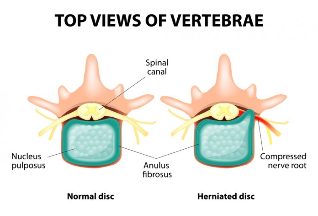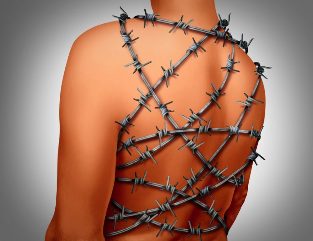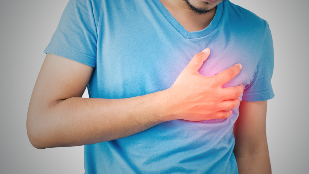Osteochondrosis of the thoracic spine is a process of chronic degenerative-dystrophic damage to the intervertebral disc and the vertebral body of the thoracic spine. This disease is somewhat less common than osteochondrosis of the cervical or lumbosacral spine. However, this does not mean that it does not cause problems for the person. Osteochondrosis of the thoracic spine is manifested primarily by pain in the back and chest, but can also cause pain in the heart, in the abdomen, similar to angina pectoris or hepatic colic. In rare cases, osteochondrosis of the thoracic spine causes the development of paresis of the muscles of the lower leg, disturbances of sensitivity in it, disorders of the pelvic organs. Treatment of this disease consists of the use of medicinal and non-medicinal methods, and sometimes surgery is required. From this article you will learn about the symptoms of osteochondrosis of the thoracic spine, and its treatment methods.
Thorax spine

The thoracic spine is represented by 12 vertebrae, between which is the intervertebral disc. The disc consists of the nucleus pulposus and the annulus fibrosus. Pathological changes in these discs, as well as in adjacent facet joints, the growth of spinal cord along the edges of the vertebral body, dystrophic processes in the spinal ligaments, and are a direct cause of back pain.
It should be noted that osteochondrosis, as a disease, rarely affects only one part of the spine. Usually this process is diffuse, more or less noticeable in different parts of the spine.
Some structural features of the thoracic spine cause it to be less frequently affected by osteochondrosis than other areas of the spine. Let's list these features:
- less thoracic spine movement;
- presence of vertebral junction points with ribs (which, in combination with the sternum, form a strong chest skeleton, less prone to injury);
- small thickness of intervertebral disc;
- physiological kyphosis (bending towards the anteroposterior with a protrusion directed backwards) of the thoracic spine, and therefore the maximum axial load falls on the anterior part rather than the back of the disc.
Another non-structural feature, but the development of thoracic spine osteochondrosis, which also determines the lower frequency of pain in the thoracic spine, is that the morphological basis of osteochondrosis in this section can remain clinically "stupid" for a long time. . That is, there is a change, but it does not bother the patient.
However, with provocative factors, such as an inactive lifestyle (including years of working at the desk or driving a car), injuries, poor posture, slack back muscles, hard physical work under duress, osteochondrosis of the thoracic spine shows its true face.
Symptoms of osteochondrosis of the thoracic spine

The main clinical symptom of thoracic spine osteochondrosis, as well as other parts, is pain. Back pain, chest pain, and even pain in the internal organs. In medicine, it is customary to distinguish some pain syndrome (and not just pain) of thoracic spine osteochondrosis. Overall, they are divided into two groups:
reflex- ;
- compression.
Reflex syndrome is a clinical manifestation of spinal receptor irritation. These are receptors for ligaments, intervertebral joint capsules, intervertebral discs, which receive pathological impulses on osteochondrosis. In addition to pain, reflex syndrome can be accompanied by muscle tension, vegetative disturbances in soft tissues and internal organs. Such a change is based on the following fact: receptor stimulation causes the spread of excitation to adjacent spinal structures (more precisely, to the spinal segment). And these can be neurons responsible for sweating in certain areas of the skin, regulating the temperature of the same area, participating in ensuring the activity of internal organs (heart, liver, intestines, etc. ), maintaining the tone of muscles and blood vessels that supply all these structures. And when joy is spread to these neurons, there are symptoms of violation of certain formation activities. Therefore, such a condition is very likely to occur when pain in the abdomen or in the heart is caused by osteochondrosis of the thoracic spine.
Compression syndrome occurs when nerve roots are compressed (less often stretched) while leaving the intervertebral foramen, spinal cord tissue or ducts that consume it. Compression syndrome is almost always caused by an existing herniated disc. The most common is a hernia of the lower thoracic segment. Depending on the direction and location of the hernia, a person experiences certain symptoms. This can be shown as follows:
- The median (median) hernia is accompanied by the development of symmetrical muscle weakness in both legs, loss of sensitivity in it. At the same time, special pain syndromes for nerve root compression are absent;
- lateral (lateral) hernia manifests exclusively pain associated with nerve root compression;
- medio-lateral hernia combines the clinical symptoms of the two previous groups, only muscle weakness and sensory disturbances present on the side of the disc.
What type of syndrome is considered in the framework of osteochondrosis of the thoracic spine? Let’s talk in more detail about this type of reflex and compression syndrome level.
Reflex syndrome
Dorsago- sharp sharp pain in the thoracic spine. This is sharp, often described by patients as a blow with a dagger. Basically, it is felt between the shoulder blades, it can be given to the heart, the sternum. The patient is afraid to move and even take a deep breath, as the pain gets stronger (as if it shoots again) from this. Often, similar symptoms occur after a long stay in a constant state of discomfort, while doing monotonous work. The sudden movement after this provokes dorsago in people with osteochondrosis of the thoracic spine. During the throbbing of the thoracic spine, the tension of the paravertebral muscles in the form of a roller and their pain is revealed.
Sometimes such pain can be considered a heart attack, so severe and sudden it feels for the patient. However, the electrocardiogram taken has no abnormalities and the use of nitroglycerin under the tongue does not relieve pain.
Dorsalgiais another type of reflex chest level syndrome. It is a gradual pain syndrome. The pain can be localized in any part of the back, chest. The pain is excruciating, dull, sometimes with a slight burning sensation (associated with irritation of vegetative structures). It is strengthened by the movement of the spine, bending, rotating around its axis, coughing or sneezing, driving on uneven roads.
Pain can be felt along the intercostal space on one or both sides. This feature is caused by nerve conductors (nerves and intercostal ducts located in the intercostal space). In this case, the pain is called intercostal neuralgia, by analogy with shingles.
If pain is localized in the anterior chest wall, it is also called pectalgia. However, it can only be felt in some places with an intact back. For example, in the area of the xiphoid process or at the site of sternocleidomastoid muscle attachment. Often, because of the dull aches and pains, it is difficult to know exactly where the pain is: either something in the chest, or in the area of superficial soft tissue.
Dorsalgias may be accompanied by paravertebral muscle reflex tension, which is more pronounced in the pain area. In this case, of course, muscle tension is not as noticeable as in similar conditions in the lumbar spine. But, during palpation, muscle compaction is felt, and the touch itself causes discomfort or pain. Also painful is palpation of the interspinous space and the paravertebral dots in the area of the segment affected by osteochondrosis.
Reflex syndrome in osteochondrosis of the thoracic spine is much more common than compression.
Compression syndrome
Nerve root compressionis accompanied, first of all, by pain syndrome. The pain radiated in nature. The direction of pain spread corresponds to the passage of nerve fibers. If thoracic osteochondrosis, this is the intercostal space. Because a number of nerve fibers form the plexus involved in the process of internal organ nerves, pain can be felt in the chest, abdomen. The pain gets stronger when moving, tilting the body, coughing, sneezing, laughing (because at these moments the root tension increases). In the compressed root zone, disturbances of sensitivity can be observed: feeling of crawling, numbness, tingling. Touching this area may not be felt. In cases where the nerve root has been compressed for a long time, movement disorders may occur, i. e. the muscle weakness it suffers from. Muscles gradually atrophy. However, movement disorders are very rare, as they are the newest in the chronology of the onset of all symptoms. Usually, a person seeks medical help at the level of pain and sensory disorders.
Spinal cord compressionmanifests itself as weakness in the legs with simultaneous increase in muscle tone (if the spinal cord is compressed at the bottom of the thoracic spine, then muscle tone decreases). Pathological symptoms of the foot may appear (Babinsky and others). Sensitivity in the lower part of the foot disappears, the sensation of touching cold and heat is no different, the difference between just a touch and an injection. If there is severe pressure on the spinal cord, urinary incontinence may occur.
Compression of blood vessels,supplies the spinal cord, leading to the development of myeloischemia, which is a lack of nutrients in the spinal cord tissue. This, as well as spinal cord compression, is accompanied by the development of muscle weakness (patients say "legs have failed"), loss of sensation and pelvic disorders.
It is fair to say that compression of the spinal cord and its ducts in osteochondrosis of the thoracic spine is extremely rare.
Vegetative components of thoracic spine osteochondrosis

Because nerve fibers originating in the thoracic spine contain autonomic conductors, irritation or violation of these fibers may be accompanied by autonomic symptoms. This can be:
- dryness and exfoliation of the skin in a separate nerve care area;
- local sweating and thermoregulation violations (also according to conservation zone);
- freshness of lower limbs, brittle toenails;
- pain simulates gastrointestinal tract diseases (e. g. , gastritis, gastric ulcer, cholecystitis, etc. );
- pain in the kidneys, which in fact has nothing to do with kidney pathology (no changes in urine and ultrasound);
- pain in the heart, very similar to angina pectoris and also myocardial infarction.
A characteristic of such pain is the fact that a person may not feel pain in the back. This is initially confusing for patients and medical staff when asking for medical help. However, conducting a number of additional research methods makes it possible to exclude pathology of internal organs, and later osteochondrosis of the thoracic spine is considered the cause of such pain.
Treatment of thoracic spine osteochondrosis
All treatment methods for thoracic spine osteochondrosis are divided into medicinal and non-drug. In most cases, only a combination of the two groups is affected, and the disease subsides. Although you need to understand that it is impossible to completely get rid of thoracic spine osteochondrosis. The degenerative process can be delayed, slowed down, but not reversed.
Medicine
The main indications of drug exposure for thoracic spine osteochondrosis are pain relief, elimination of muscle tension, increased microcirculation and tissue trophism.
Nonsteroidal anti-inflammatory drugs have been used successfully to relieve pain syndrome. Drugs in this group have the ability to reduce inflammatory processes, relieve pain, and inhibit platelet aggregation. The drugs are prescribed, on average, for 7-14 days. This is usually enough to relieve the pain. Many of them are available in various forms (tablets, capsules, solutions for injections, rectal suppositories), which ensures ease of use. In the first days of treatment, the drugs are used in the form of injections, and then they are switched to tablets or suppositories. The same drug can be used simultaneously topically: on the thoracic spine. Moreover, for this purpose there are also various forms of relief: creams, ointments, gels, plasters.
Sometimes non-steroidal anti-inflammatory drugs are not enough to relieve pain. In such cases, use the use of an analgesic mixture. The mixture is injected intravenously in a solution of salt or glucose.
Paravertebral blockade has a pretty good and fast analgesic effect. This is a type of medical manipulation, when the drug is injected near the spine intracutally, subcutaneously, into the thickness of muscle tissue, perineurally (right near the nerve or root). The procedure requires certain skills and experience from the doctor.
Also, local irritating and irritating ointments can be used to relieve pain in thoracic spine osteochondrosis. This is an ointment that contains snake venom, bee venom, and pepper extract.
Muscle tension is reduced by non-drug methods.
Diuretics, hormones, Escina Lysinat are used to relieve nerve root edema.
Pentoxifylline, Dipyridamole, Complamin, nicotinic acid are used to normalize blood circulation, improve tissue nutrition and restore trophism.
In osteochondrosis of the thoracic spine, vitamin B is indicated, which has analgesic and neurotropic effects.
When the worsening of osteochondrosis of the thoracic spine is caught, you can use the use of drugs that increase the metabolism of the disc and intervertebral joints. These are what are called chondroprotectors. These drugs stimulate the regrowth of articular cartilage, delaying the degenerative process in the intervertebral disc. They are prescribed for a long time (3-6 months).
Non-drug methods
This includes:
- sequence (classic, point, reflex-segment);
- physiotherapy training;
- spasmodic muscle stretching (there are special techniques, stretching is not done according to the principle "as you wish");
- acupuncture;
- swimming (very useful for all patients with localization of osteochondrosis);
- physiotherapy (ultrasound, electrophoresis, amplipulse, diadynamic current, mud therapy, etc. ).
If a hernia is formed as a result of osteochondrosis of the thoracic spine pressing on the spinal cord, its ducts or nerve roots, and at the same time causing muscle weakness, pelvic organ dysfunction, pronounced pain syndrome (resistant to drug use), then the question will be consideredperforming surgical treatment.
Osteochondrosis of the thoracic spine is not a deadly disease, but causes many dangers to sick people. This limits his life, interferes with work and a good rest. The main symptom of osteochondrosis of the thoracic spine is pain. It is impossible to get rid of the disease completely, but it is possible to delay the degenerative process and minimize its manifestations.





































